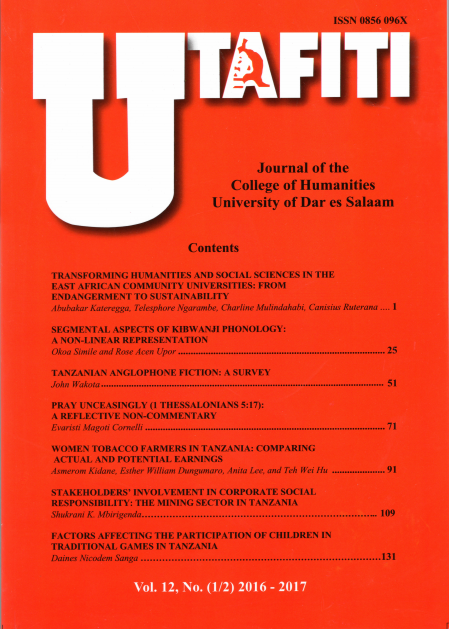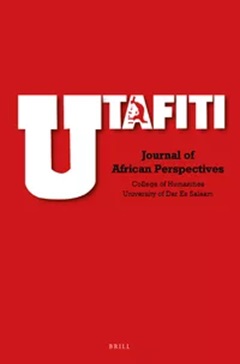WOMEN TOBACCO FARMERS IN TANZANIA: COMPARING ACTUAL AND POTENTIAL EARNINGS
Abstract
This study attempts to measure women tobacco farmers ' labour input in Tanzania. A comparison is made with two other crops - maize and vegetables. For the coffee production cycle, women farmers ' output share
was estimated to be 1.97 million Tanzanian shillings. Assuming alternative employment were available at a minimum wage, women tobacco farmers would earn 5.7 million Tanzanian shillings, almost a three fold increase if they did work other than farm tobacco. Besides this, 72.58% of total women ' s labour for the period was earmarked for tobacco growing, while only 35.58% of total earnings are generated from tobacco production. 20.68% of women ' s labour was earmarked for maize growing; on the other hand 39.20% of total revenue is generated from maize production. Only 6.74% of womens ' labour was earmarked for growing vegetables; whereas a substantial 25.22% of total revenue is generated from production of vegetables A Cobb Douglas type production was estimated, where output was regressed on labour input and acreage. While the returns from extra one-acre input were substantial and significant, returns
from an extra one unit of labour yielded insignificant results. In other words, besides being hazardous to health, planting tobacco is not a worthwhile undertaking. Alternative employment should be sought.
Key words: Tanzania, women, tobacco, farmers, labour input, labour output
References
Bennett, E. P. 2008. Manning the Fields: Remaking Women's Work in the Tobacco South in the Twentieth Century. The Journal of Peasant
Studies 35(4): 720-741.
Boserup, E. 1970. Women ' s Role in Economic Development. New York: St. Martins ' Press.
Boserup, E. 1985. Economic and Demographic Interrelationships in SubSaharan Africa. Population and Development Review 11(3): 383397.
Bryceson, D. F., Gough, K.V., Rigg, J., and Agergaard, J. 2009. Critical Commentary. The World Development Report 2009. Urban
Studies 46(4): 723-738.
Bryceson, D., Maunder, D., Mbara, T. C., R., Kibombo, A. S., Davis, C., and Howe, J. 2003. Sustainable livelihoods, mobility and access needs. TRL Report 544. Transport Research Laboratory Limited.
Crow, M.E. 2005. The human rights responsibilities of multinational tobacco companies. Tobacco Control 14 (suppl. II): 14-18.
Dixon, R. 1982. Women in Agriculture: Counting the Labour Force in Developing Countries. Population and Development Review 8(3): 539-566.
Doss, Cheryl. 2011. The Role of Women in Agriculture. The State of Food and Agriculture (SOFA). www.fao.org/economic/esa. Accessed 29 November, 2016.
Dungumaro, E. W. 2013. Consequences of Female Migration for Families in Areas of Origin in Tanzania. African Review of Economics and Finance 5(1): 46-59.
Fong, M. 1980. Statistics on women's participation in agricultural
production. Rome: Food and Agriculture Organization of the
United Nations.
Food and Agriculture Organisation of the United Nations (FAO) Statistics. 2014. FAOSTAT. Food and Agricultural Trade.
http://faostat.fao.org/site/342/default.aspx. [Ref list] Accessed
November 29, 2014.
Gawaya, R. 2008. Investing in women farmers to eliminate food insecurity in southern Africa: Policy-related research from Mozambique. Gender and Development 16(1): 147-159.
Geist, H.J, Chang, K.T, Etges, V. and Abdallah, J.M. 2009. Tobacco
growers at the crossroads: Towards a comparison of diversification
and ecosystem impacts. Land Use Policy 26: 1066-1079.
Goody, J. 1976. Production and Reproduction: A Comparative Study of the Domestic. Cambridge: Cambridge University.
Haviland, W. E. 1954. The Use and Efficiency of Afican labour in
Tobacco Farming in Southern Rhodesia. The Canadian Journal of
Economic and Political Science 20(1): 100-106.
Holmes, R. and Slater, R. 2008. Measuring Progress on Gender and Agriculture in the 1982 and 2008 World Development Reports.
Gender and Development 16(1): 27-40.
International Center for Research on Women. 1980. The productivity of women in developing countries: Measurement issues and recommendations. Washington, D.C: Office of Women in Development, US Agency for International Development, April.
Jain, D., Singh, N., and Chand, M. 1979. Women's work: Methodological issues. In: Women and Development: Perspectives from South and Southeast Asia. Eds. Rounaq Jahan and Hanna Papanek. Dacca: The Bangladesh Institute of Law and International Affairs.
Kidane, A., Hepelwa, A., Ngeh, E. and Hu, T. 2013. Agricultural Input and Efficiency in Tanzania Small Scale Agriculture: A comparative Analysis of Tobacco and Selected Food Crops. Tanzania Economic Review, 3. 2013 pp 1-15.
Kidane, A., Hepelwa, A., Ngeh, E. and Hu, T. 2015. Comparative Analysis of Technical Efficiency of Smallholder Tobacco and Maize
Farmers in Tabora, Tanzania. Journal of Development and
Agricultural Economics 7:2: 72-79.
Krane, R.E. 1973. Effects of Cyclical International Migration upon SocioEconomic Mobility. International Migration Review 7: 427-436.
Lockwood, V.S. 1990. Development and Return Migration to Rural
Polynesia. International Migration Review 24(2): 347-371.
Mbilinyi, M. 1985. €—City ' and €—countryside ' in colonial Tanganyika.
Economic and Political Weekly 20(43): 88-96.
Meeker, J., and Meekers, D. 1992. The Precarious Socio-Economic
Position of Women in Rural Africa: The Case of the Kaguruof
Tanzania. African Studies Review 40(1): 35-58.
Mendonsa, E. L. 1982. Benefits of Migration as a Personal Strategy in Nazare, Portugal, International Migration Review 16(3): 635-645.
Mutangadura, G. 2001. Households Under Socio-Economic Stress: The Case of Zimbabwe's Urban Areas and Implications for Development. Harare: Macmillan.
Oppong, C. 1997. The African family and the status of women ' s health. In: Family, Population and Development in Africa. Ed. Aderanti Adepoju. London: Zed Books, pp. 158-182.
Otañez, M. 2008. Social disruption caused by tobacco growing. Study conducted for the Second meeting of the Study Group on
Economically Sustainable Alternatives to Tobacco Growing -WHO
Framework Convention on Tobacco Control, Mexico City, Mexico,
-19 June, pp: 46.
Pearce, D. 1978. The Feminization of Poverty: Women, Work, and
Welfare. Urban and Social Change Review 11 (February): 28-36.
Perez-Ramirez, G. 1978. Unveiling women in statistics. Populi 5(1): 1722.
Peters, P. 1983. Developmental cycles and historical process: a critique of recent research on women in Botswana, Journal of Southern African Studies 10(1): 100-122.
Peterson, Janice. 1987. The Feminization of Poverty. Journal of Economic Issues 21 (March): 329-337.
Rhodes, R. E. 1977. Intra-European Return Migration and Rural
Development: Less from Spanish Case. Human Organization 31:
-147.
Rogers, B. 1980. The Domestication of Women. New York: St. Martin's Press.
Staudt, K. 1988. Women farmers in Africa: Research and Institutional Action, 1972-1987. Canadian Journal of African Studies 22(3): 567-582.
United of Republic Tanzania. Ministry of Agriculture and Food. (MoAF). 1999. National Agricultural Statistics. AGSTATS. United Republic of Tanzania.
United Republic of Tanzania. 2016. Bank of Tanzania Annual Report 2014/15.
World Bank. 2000. Dynamic Cities as Engines of Growth. World
Development Report, World Bank, Oxford: Oxford University
Press, 125-138.
Youssef, N. 1977. Women and agricultural production in Muslim societies. Studies in Comparative International 12(1): 41-58.



